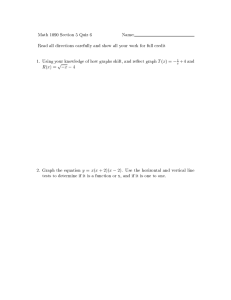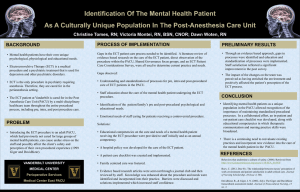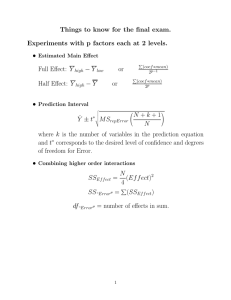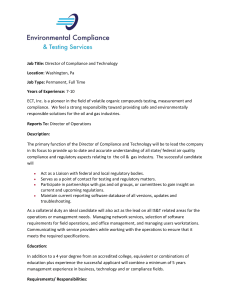Identification Of The Mental Health Patient
advertisement
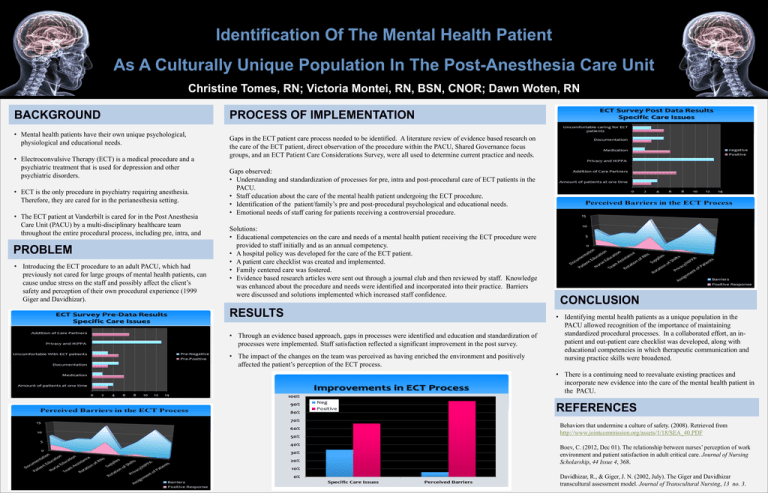
Identification Of The Mental Health Patient As A Culturally Unique Population In The Post-Anesthesia Care Unit Christine Tomes, RN; Victoria Montei, RN, BSN, CNOR; Dawn Woten, RN BACKGROUND • Mental health patients have their own unique psychological, physiological and educational needs. • Electroconvulsive Therapy (ECT) is a medical procedure and a psychiatric treatment that is used for depression and other psychiatric disorders. • ECT is the only procedure in psychiatry requiring anesthesia. Therefore, they are cared for in the perianesthesia setting. • The ECT patient at Vanderbilt is cared for in the Post Anesthesia Care Unit (PACU) by a multi-disciplinary healthcare team throughout the entire procedural process, including pre, intra, and post procedure care. PROBLEM • Introducing the ECT procedure to an adult PACU, which had previously not cared for large groups of mental health patients, can cause undue stress on the staff and possibly affect the client’s safety and perception of their own procedural experience (1999 Giger and Davidhizar). PROCESS OF IMPLEMENTATION Gaps in the ECT patient care process needed to be identified. A literature review of evidence based research on the care of the ECT patient, direct observation of the procedure within the PACU, Shared Governance focus groups, and an ECT Patient Care Considerations Survey, were all used to determine current practice and needs. Gaps observed: • Understanding and standardization of processes for pre, intra and post-procedural care of ECT patients in the PACU. • Staff education about the care of the mental health patient undergoing the ECT procedure. • Identification of the patient/family’s pre and post-procedural psychological and educational needs. • Emotional needs of staff caring for patients receiving a controversial procedure. Solutions: • Educational competencies on the care and needs of a mental health patient receiving the ECT procedure were provided to staff initially and as an annual competency. • A hospital policy was developed for the care of the ECT patient. • A patient care checklist was created and implemented. • Family centered care was fostered. • Evidence based research articles were sent out through a journal club and then reviewed by staff. Knowledge was enhanced about the procedure and needs were identified and incorporated into their practice. Barriers were discussed and solutions implemented which increased staff confidence. RESULTS • Through an evidence based approach, gaps in processes were identified and education and standardization of processes were implemented. Staff satisfaction reflected a significant improvement in the post survey. • The impact of the changes on the team was perceived as having enriched the environment and positively affected the patient’s perception of the ECT process. CONCLUSION • Identifying mental health patients as a unique population in the PACU allowed recognition of the importance of maintaining standardized procedural processes. In a collaborated effort, an inpatient and out-patient care checklist was developed, along with educational competencies in which therapeutic communication and nursing practice skills were broadened. • There is a continuing need to reevaluate existing practices and incorporate new evidence into the care of the mental health patient in the PACU. REFERENCES Behaviors that undermine a culture of safety. (2008). Retrieved from http://www.jointcommission.org/assets/1/18/SEA_40.PDF Boev, C. (2012, Dec 01). The relationship between nurses’ perception of work environment and patient satisfaction in adult critical care. Journal of Nursing Scholarship, 44 Issue 4, 368. Davidhizar, R., & Giger, J. N. (2002, July). The Giger and Davidhizar transcultural assessment model. Journal of Transcultural Nursing, 13 no. 3.
